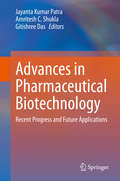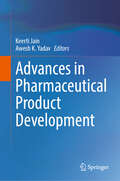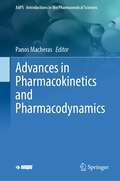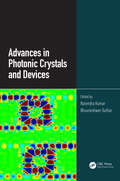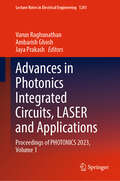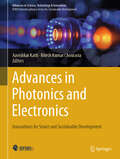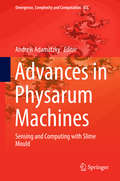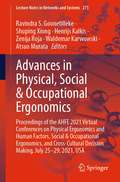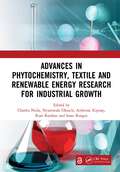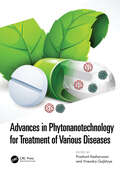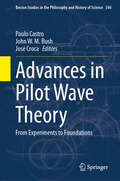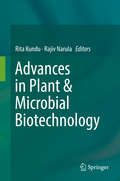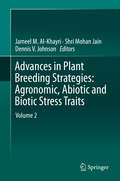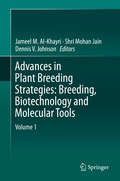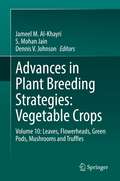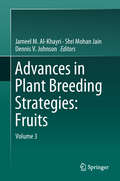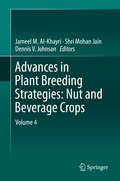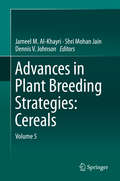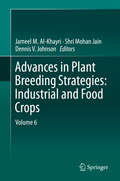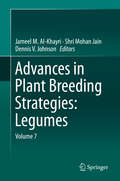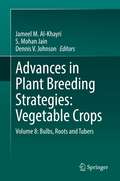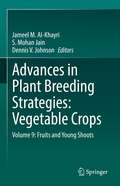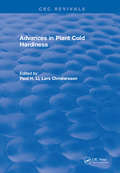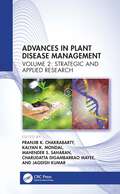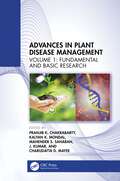- Table View
- List View
Advances in Pharmaceutical Biotechnology: Recent Progress and Future Applications
by Jayanta Kumar Patra Gitishree Das Amritesh C. ShuklaThis book explains both the basic science and the applications of biotechnology-derived pharmaceuticals, with special emphasis on their clinical uses. The foundations of pharmaceutical biotechnology lie mainly in the capability of plants, microorganism, and animals to produce low and high molecular weight compounds useful as therapeutics. Pharmaceutical biotechnology has flourished since the advent of recombinant DNA technology and metabolic engineering, supported by the well-developed bioprocess technology. A large number of monoclonal antibodies and therapeutic proteins have been approved, delivering meaningful contributions to patients’ lives, and the techniques of biotechnology are also a driving force in modern drug discovery. Due to this rapid growth in the importance of biopharmaceuticals and the techniques of biotechnologies to modern medicine and the life sciences, the field of pharmaceutical biotechnology has become an increasingly important component in the education of pharmacists and pharmaceutical scientists. This book will serve as a complete one-stop source on the subject for undergraduate and graduate pharmacists, pharmaceutical science students, and pharmaceutical scientists in industry and academia.
Advances in Pharmaceutical Product Development
by Keerti Jain Awesh K. YadavThis book discusses the stages involved in pharmaceutical product development including the importance, requirement, and effect of each stage and process. It also covers prototype development for pharmaceutical formulations, scale-up studies, optimization, testing, packaging, and commercialization of different dosage forms for pharmaceutical products like tablets, suspensions, emulsions, coating, inhalational products, sterile products, and herbal formulations. The book also presents advancements in tablet production and tablet coating, including materials, material handling, granulation and granulation technologies, process automation, processing problems in tablet production and troubleshooting, advances in equipment for coating and coating materials. Further, the chapter explores the advances in the formulation and development of aerosols, nebulizers, inhalers, metered Dose Inhalers (MDI), and dry powder Inhalers (DPIs). Towards the end, the book examines the challenges, formulation development, testing, stability, and regulatory guidelines in the development of herbal formulations. This book provides a valuable source of information for the researcher, scientists, students, and people working in the area mainly focused on the challenges in pharmaceutical product development.
Advances in Pharmacokinetics and Pharmacodynamics (AAPS Introductions in the Pharmaceutical Sciences #9)
by Panos MacherasThis book provides a concise overview of recent advances in Pharmacokinetics (PK) and Pharmacodynamics (PD). The pharmacokinetics section covers the state of the art in Physiologically Based Pharmacokinetic (PBPK) modeling (Chapter 1) as well as the assessment of food effect on drug absorption using PBPK modeling (Chapter 2). Chapters 3 and 4 describe the recent development of Physiologically Based Finite Time Pharmacokinetic (PBFTPK) models and their applications to pharmacokinetic data. The pharmacodynamics section focuses on PK/PD modeling. Chapter 5 provides an overview of PK/PD modeling and simulation in clinical practice and studies. Chapter 6 deals with the subject/physiology variability issue encountered in PK/PD studies, while Chapter 7 reviews the influence of clinical pharmacology in the modernization of drug development and regulation. This book is an essential reference for pharmaceutical scientists.
Advances in Photonic Crystals and Devices
by Narendra Kumar Bhuvneshwer SutharIn recent decades, there has been a phenomenal growth in the field of photonic crystal research and has emerged as an interdisciplinary area. Photonic crystals are usually nanostructured electromagnetic media consisting of periodic variation of dielectric constant, which prohibit certain electromagnetic wave frequency ranges called photonic bandgaps to propagate through them. Photonic crystals elicited numerous interesting features by unprecedented control of light and their exploitation is a promising tool in nanophotonics and designing optical components. The book ‘Advances in Photonic Crystals and Devices’ is designed with 15 chapters with introductory as well as research and application based contents. It covers the following highlighted features: Basics of photonic crystals and photonic crystal fibers Different theoretical as well as experimental approaches Current research advances from around the globe Nonlinear optics and super-continuum generation in photonic crystal fibers Magnetized cold plasma photonic crystals Liquid crystal defect embedded with graphene layers Biophysics and biomedical applications as optical sensors Two-dimensional photonic crystal demultiplexer Optical logic gates using photonic crystals A large number of references The goal of this book is to draw the background in understanding, fabrication and characterization of photonic crystals using a variety of materials and their applications in design of several optical devices. Though the book is useful as a reference for the researchers working in the area of photonics, optical computing and fabrication of nanophotonic devices, it is intended for the beginners like students pursuing their masters’ degree in photonics.
Advances in Photonics Integrated Circuits, LASER and Applications: Proceedings of PHOTONICS 2023, Volume 1 (Lecture Notes in Electrical Engineering #1241)
by Jaya Prakash Varun Raghunathan Ambarish GhoshThis book presents the select proceedings of the Biennial Photonics Conference (Photonics 2023) held at IISc, Bengaluru on 5-8 July 2023. It covers topics across multiple areas of photonics, including established areas like optical communication and networks, quantum optics, non-linear and ultrafast photonics, nanophotonics, biophotonics and bioimaging, photonic integrated circuits, fibers and sensors, optical materials and fabrication techniques, optical metrology, and instrumentation, optofluidics, laser applications, optoelectronics. The book also covers emerging areas in photonics, such as THz photonics, structured Light, 2D materials, optomechanics, topological photonics, and AI/ML in photonics. The book will be useful for researchers and professionals interested in the broad field of photonics.
Advances in Photonics and Electronics: Innovations for Smart and Sustainable Development (Advances in Science, Technology & Innovation)
by Aavishkar Katti Ritesh Kumar ChourasiaThe book presents the collated and high-quality proceedings of the Conference on Recent Technologies in Electronics and Photonics held during 9-10 February 2024 at MIT-WPU, Pune, India. The main objective of this book is the introduction of recent innovations and current trends of photonics and electronics along with advanced device applications. Photonics and electronics together are shaping up to be the two main pillars of innovation for sustainable development and technological advances. The emphasis in this book will be on presenting recent application-based research in the mentioned fields rather than purely theoretical ideas. The readers will gain insights on recent innovations across many fields of photonics on one hand: laser science and nonlinear optics, photonic materials, nanophotonics, solar photovoltaics, optoelectronics, green photonics, and fiber optics and a diverse set of topics in electronics on the other: Semiconductor Electronics, Electronic Materials, Microelectronics, AI/ML, Internet of Things etc. The book is useful for early career researchers in Science and Engineering, as also university professors and industry professionals.
Advances in Physarum Machines: Sensing and Computing with Slime Mould (Emergence, Complexity and Computation #21)
by Andrew AdamatzkyThis book is devoted to Slime mould Physarumpolycephalum, which is a large single cell capable for distributed sensing,concurrent information processing, parallel computation and decentralizedactuation. The ease of culturing and experimenting with Physarum makes thisslime mould an ideal substrate for real-world implementations of unconventionalsensing and computing devices The book is a treatise of theoretical and experimentallaboratory studies on sensing and computing properties of slime mould, and onthe development of mathematical and logical theories of Physarum behavior. It is shown how to make logical gates and circuits,electronic devices (memristors, diodes, transistors, wires, chemical andtactile sensors) with the slime mould. The book demonstrates how to modifyproperties of Physarum computing circuits with functional nano-particles andpolymers, to interface the slime mould with field-programmable arrays, and touse Physarum as a controller of microbial fuel cells. A unique multi-agent model of slime is shown to servewell as a software slime mould capable for solving problems of computationalgeometry and graph optimization. The multiagent model is complemented bycellular automata models with parallel accelerations. Presented mathematical modelsinspired by Physarum include non-quantum implementation of Shor'sfactorization, structural learning, computation of shortest path tree ondynamic graphs, supply chain network design, p-adic computing and syllogisticreasoning. The book is a unique composition of vibrant andlavishly illustrated essays which will inspire scientists, engineers andartists to exploit natural phenomena in designs of future and emergentcomputing and sensing devices. It is a 'bible' of experimental computing withspatially extended living substrates, it spanstopics from biology of slime mould, to bio-sensing, tounconventional computing devices and robotics, non-classical logics and music and arts.
Advances in Physical, Social & Occupational Ergonomics: Proceedings of the AHFE 2021 Virtual Conferences on Physical Ergonomics and Human Factors, Social & Occupational Ergonomics, and Cross-Cultural Decision Making, July 25-29, 2021, USA (Lecture Notes in Networks and Systems #273)
by Waldemar Karwowski Ravindra S. Goonetilleke Atsuo Murata Shuping Xiong Henrijs Kalkis Zenija RojaThis book reports on cutting-edge findings and developments in physical, social and occupational ergonomics. It covers a broad spectrum of studies and evaluation procedures concerning physical and mental workload, work posture and ergonomic risk. Further, it reports on significant advances in the design of services and systems, including those addressing special populations, for purposes such as health, safety and education, and discusses solutions for a better and safer integration of humans, automated systems and digital technologies. The book also analyzes the impact of culture on people’s cognition and behavior, providing readers with timely insights into theories on cross-cultural decision-making, and their diverse applications for a number of purposes in businesses and societies. Based on the AHFE 2021 conferences on Physical Ergonomics and Human Factors, Social & Occupational Ergonomics, and Cross-Cultural Decision Making, held virtually on 25–29 July, 2021, from USA, it provides readers with a comprehensive overview of the current challenges in physical, social and occupational ergonomics, including those imposed by technological developments, highlights key connections between them, and puts forward optimization strategies for sociotechnical systems, including their organizational structures, policies and processes.
Advances in Phytochemistry, Textile and Renewable Energy Research for Industrial Growth: Proceedings of the International Conference of Phytochemistry, Textile and Renewable Energy for Sustainable development (ICPTRE 2020), August 12-14, Eldoret, Kenya
by Dr Charles NzilaThe International Conference on Phytochemistry, Textile, & Renewable Energy Technologies for Sustainable Development (ICPTRE 2020) was hosted by the World bank funded Africa Centre of Excellence in Phytochemicals, Textile and Renewable Energy (ACEII-PTRE) based at Moi University in conjunction with Donghua University, China and the Sino–Africa International Symposium on Textiles and Apparel (SAISTA). The theme of the conference was Advancing Science, Technology and Innovation for Industrial Growth. The research relationships between universities and industry have enabled the two entities to flourish and, in the past, have been credited for accelerated sustainable development and uplifting of millions out poverty. ICPTRE 2020 therefore provided a platform for academic researchers drawn from across the world to meet key industry professionals and actively share knowledge while advancing the role of research in industrial development, particularly, in the developing nations. The conference also provided exhibitors with an opportunity to interact with professionals and showcase their business, products, technologies and equipment. During the course of the conference, industrial exhibitions, research papers and presentations in the fields of phytochemistry, textiles, renewable energy, industry, science, technology, innovations and much more were presented.
Advances in Phytonanotechnology for Treatment of Various Diseases
by Prashant Kesharwani Virendra GajbhiyeSeveral plant bioactives or plant-derived therapeutic molecules have been used against life-threatening diseases and their nanoparticle-mediated delivery greatly improves therapeutic efficacy. Advances in Phytonanotechnology for Treatment of Various Diseases aims to describe past and recent advances achieved in the field of phytonanotechnology. The chapters of this book provide thorough knowledge of medicinal plants, plant bioactives, plant extract-based nanoparticle synthesis, delivery of plant bioactives through nanoparticles, and their therapeutic activity against life-threatening diseases. This book focuses on the therapeutic activity of phytocomponents present in plants from diverse families, genera, and species. The book also covers future aspects and challenges present in phytonanotechnology for curing human diseases. This book fulfils the thrust of researchers working in this field, which further encourages them to make new discoveries in this area and support the development of effective nanoparticle-mediated plant bioactive delivery platforms for treating human diseases. Key Features Provides information on medicinal plants and plant bioactives used in the treatment of various life-threatening diseases Covers green synthesis of nanoparticles as well as their toxicological and biological effects Explores various nanocarriers routinely used in the delivery of plant bioactives and their efficacy for future drug delivery Envisages future opportunities, challenges, and implementation made in phytonanotechnology-based treatment of human diseases
Advances in Pilot Wave Theory: From Experiments to Foundations (Boston Studies in the Philosophy and History of Science #344)
by Paulo Castro John W. M. Bush José CrocaThis book provides a state-of-the-art review of Pilot Wave Theory at the beginning of the XXI century. It contains the best contributions of the first International Conference on Advances in Pilot Wave Theory, held in Lisbon in 2021. The event brought together physicists from the new emerging field of Hydrodynamic Quantum Analogs (HQA) and philosophers of science. Three main themes were discussed: 1. Hydrodynamic quantum analogs, 2. Theoretical advances in pilot wave physics and, 3. Philosophical foundations of pilot wave theory. Recent experimental work in HQA has provided impetus to develop the pilot-wave approach into a realistic basis of quantum mechanics, specifically a dynamical completion of the existing theory of quantum statistics. To that end, the meeting featured theoretical work that advanced Louis de Broglie original pilot wave theory. This collection shows how several aspects of quantum systems have been reproduced in the hydrodynamic environment, and how the power of analogy suggests the possibility of a relatively intelligible quantum realm. Most notably, the notion of memory, as engendered in the pilot-wave-hydrodynamic system, suggests a profitable direction to explore in developing a more complete description of quantum phenomena. This book is expected to be of great interest to physicists, computer scientists and philosophers of science interested in the foundations of Quantum Mechanics. Chapter 1 and Chapter 12 are available open access under a Creative Commons Attribution 4.0 International License via link.springer.com.
Advances in Plant & Microbial Biotechnology
by Rita Kundu Rajiv NarulaBiotechnology refers to the use or manipulation of an organism or parts of an organism. While the early applications were certainly simpler (though still relevant), modern plant biotechnology is primarily associated with molecular biology, cloning and genetic engineering. Over the last 50 years, several key discoveries have revolutionized the biological sciences and enabled the rapid growth of the biotechnology industry.This book gathers handpicked articles presented by national and international scientists at the International Conference on Biotechnology and Biological Sciences, BIOSPECTRUM 2017. It highlights the works of researchers and students in India and abroad on plant biotechnology and its applications in addressing various agricultural and food production-related issues.The respective papers explore a range of advances in plant biotechnology, e.g.: the cytotoxic potential of Moringaoleifera lam; the use of the entomo-pathogenic fungi Cordyceps sp. as unique and valuable sources of bioactive compounds; and strain improvement strategies for Cordyceps sp. In addition, they discuss the use of low-cost blue green algal biofertilizer comprising four blue green algal strains in rice fields; and the use of lignocellulosic materials as potential renewable energy resources for the production of fuels.This book will be extremely useful for researchers and students of biotechnology and plant science, providing an essential update on the latest findings and trends.
Advances in Plant Breeding Strategies: Agronomic, Abiotic and Biotic Stress Traits
by Shri Mohan Jain Jameel M. Al-Khayri Dennis V. JohnsonThe basic concept of this book is to examine the use of innovative methods augmenting traditional plant breeding towards the development of new crop varieties under different environmental conditions to achieve sustainable food production. This book consists of two volumes: Volume 1 subtitled Breeding, Biotechnology and Molecular Tools and Volume 2 subtitled Agronomic, Abiotic and Biotic Stress Traits. This is volume 2 which contains 18 chapters highlighting breeding strategies for specific plant traits including improved nutritional and pharmaceutical properties as well as enhanced tolerance to insects, diseases, drought, salinity and temperature extremes expected under predicted global climate change.
Advances in Plant Breeding Strategies: Breeding, Biotechnology and Molecular Tools
by Shri Mohan Jain Jameel M. Al-Khayri Dennis V. JohnsonThe basic concept of this book is to examine the use of innovative methods augmenting traditional plant breeding towards the development of new crop varieties under different environmental conditions to achieve sustainable food production. This book consists of two volumes: Volume 1 subtitled Breeding, Biotechnology and Molecular Tools and Volume 2 subtitled Agronomic, Abiotic and Biotic Stress Traits. This is Volume 1 which consists of 21 chapters covering domestication and germplasm utilization, conventional breeding techniques and the role of biotechnology. In addition to various biotechnological applications in plant breeding, it includes functional genomics, mutations and methods of detection, and molecular markers. In vitro techniques and their applications in plant breeding are discussed with an emphasis on embryo rescue, somatic cell hybridization and somaclonal variation. Other chapters cover haploid breeding, transgenics, cryogenics and bioinformatics.
Advances in Plant Breeding Strategies: Volume 10: Leaves, Flowerheads, Green Pods, Mushrooms and Truffles
by S. Mohan Jain Jameel M. Al-Khayri Dennis V. JohnsonPlant breeders and geneticists are under constant pressure to sustain and expand food production by using innovative breeding strategies and introducing minor crops, which are well adapted to marginal lands, provide a source of nutrition, and have abiotic and biotic stress tolerance, to feed an ever-increasing human population. The basic concept of this book is to examine the use of innovative methods, augmenting traditional plant breeding, towards the improvement and development of new crop varieties, under the increasingly limiting environmental and cultivation factors, to achieve sustainable agricultural production and enhanced food security. Three volumes of the book series Advances in Plant Breeding Strategies were published in 2015, 2016 and 2018, respectively: Volume 1. Breeding, Biotechnology and Molecular Tools; Volume 2. Agronomic, Abiotic and Biotic Stress Traits and Volume 3. Fruits. In 2019, the following four volumes were published: Volume 4. Nut and Beverage Crops, Volume 5. Cereals, Volume 6. Industrial and Food Crops and Volume 7. Legumes. In 2021, three volumes are being concurrently published: Volume 8. Vegetable Crops: Bulbs, Roots and Tubers, Volume 9. Vegetable Crops: Fruits and Young Shoots and Volume 10. Vegetable Crops: Leaves, Flowerheads, Green Pods, Mushrooms and Truffles. This Volume 10, subtitled Vegetable Crops: Leaves, Flowerheads, Green Pods, Mushrooms and Truffles, consists of 14 chapters focusing on advances in breeding strategies using both traditional and modern approaches for the improvement of individual vegetable crops. Chapters are arranged in 4 parts according to the edible vegetable parts. Part I: Leaves - Chicory (Cichorium intybus L.), Chinese cabbage (Brassica rapa L. var. pekinensis), Rocket salad (Eruca vesicaria ssp. sativa Mill.), Spring onion (Allium fistulosum L.),Water spinach (Ipomoea aquatica Forsk.) and Watercress (Nasturtium officinale R. Br.); Pat II: Flowerheads and Green Pods - Cauliflower (Brassica oleracea var. botrytis L.), Globe artichoke (Cynara cardunculus var. scolymus L.), Garden pea (Pisum sativum L.) and Yardlong bean (Vigna unguiculata (L.) Walp. ssp. sesquipedalis (L.) Verdc.); Part III: Mushrooms - Enoki mushroom (Flammulina velutipes (Curtis) Singer) and Shiitake mushroom (Lentinula edodes (Berk.) Sing.); Part IV: Truffles - Desert truffles (Terfezia spp.) and White truffle (Tuber magnatum Picco and T. borchii Vittad.). Each chapter comprehensively reviews the contemporary literature on the subject and reflects the experiences of the authors. Chapters are written by internationally-reputable scientists and subjected to a review process to assure quality presentation and scientific accuracy. Each chapter begins with an introduction covering related backgrounds and provides in-depth discussion of the subject supported with high-quality color photos, illustrations and relevant data. The chapter concludes with recommendations for future research directions, a comprehensive list of pertinent references to facilitate further reading, and appendixes of genetic resources and concerned research institutes. This book series is a valuable resource for advanced students, researchers, scientists, commercial producers and seed companies as well as consultants and policymakers interested in agriculture, particularly in modern breeding technologies.
Advances in Plant Breeding Strategies: Volume 3
by Shri Mohan Jain Jameel M. Al-Khayri Dennis V. JohnsonThis book examines the development of innovative modern methodologies towards augmenting conventional plant breeding for the production of new crop varieties, under the increasingly limiting environmental and cultivation factors, to achieve sustainable agricultural production and enhanced food security. Two volumes of Advances in Plant Breeding Strategies were published in 2015 and 2016, respectively; Volume 1: Breeding, Biotechnology and Molecular Tools and Volume 2: Agronomic, Abiotic and Biotic Stress Traits. This is Volume 3: Fruits, which is focused on advances in breeding strategies for the improvement of individual fruit crops. It consists of 23 chapters grouped into three parts, according to distribution classification of fruit trees: Part I, Temperate Fruits, Part II, Subtropical Fruits, and Part III, Tropical Fruits. Each chapter comprehensively reviews the modern literature on the subject and reflects the authors' own experience.
Advances in Plant Breeding Strategies: Volume 4
by Shri Mohan Jain Jameel M. Al-Khayri Dennis V. JohnsonThis book examines the development of innovative modern methodologies towards augmenting conventional plant breeding, in individual crops, for the production of new crop varieties under the increasingly limiting environmental and cultivation factors to achieve sustainable agricultural production, enhanced food security, in addition to providing raw materials for innovative industrial products and pharmaceuticals. This Volume 4, subtitled Nut and Beverage Crops, focuses on advances in breeding strategies using both traditional and modern approaches for the improvement of individual plantation crops. Included in Part I, eleven important nut species recognized for their economical and nutritional importance including Almond, Argan, Brazil nut, Cashew nut, Chestnut, Hazelnut, Macadamia, Peanut, Pine nut, Pistachio and Walnut. Part II covers two popular beverage species, coffee and tea. This volume is contributed by 53 internationally reputable scientists from 13 countries. Each chapter comprehensively reviews the modern literature on the subject and reflects the authors own experience.
Advances in Plant Breeding Strategies: Volume 5
by Shri Mohan Jain Jameel M. Al-Khayri Dennis V. JohnsonThis book examines the development of innovative modern methodologies towards augmenting conventional plant breeding, in individual crops, for the production of new crop varieties under the increasingly limiting environmental and cultivation factors to achieve sustainable agricultural production, enhanced food security, in addition to providing raw materials for innovative industrial products and pharmaceuticals. This Volume 5, subtitled Cereals, focuses on advances in breeding strategies using both traditional and modern approaches for the improvement of individual crops. It addresses important staple food crops including barley, fonio, finger millet, foxtail millet, pearl millet, proso millet, quinoa, rice, rye, tef, triticale and spelt wheat. The volume is contributed by 53 internationally reputable scientists from 14 countries. Each chapter comprehensively reviews the modern literature on the subject and reflects the authors own experience.
Advances in Plant Breeding Strategies: Volume 6
by Shri Mohan Jain Jameel M. Al-Khayri Dennis V. JohnsonThis book examines the development of innovative modern methodologies towards augmenting conventional plant breeding, in individual crops, for the production of new crop varieties under the increasingly limiting environmental and cultivation factors to achieve sustainable agricultural production, enhanced food security, in addition to providing raw materials for innovative industrial products and pharmaceuticals. This is Vol 6, subtitled Industrial and Food Crops, which consists of two parts. Included in Part I are 11 industrial plant species utilized as sources of raw materials for the production of industrial products including pulp and wood crops (acacia), fiber (cotton, jute and ramie), rubber (guayule and rubber tree), oil (jojoba and flax), biofuels and pharmaceutical (agave) and sugar source (sugarcane). Part II covers 7 food plants selected for their utilization in food industries for the production of chocolate (cacao), cooking oil (oil palm, safflower, sesame and sunflower) and natural flavors and aroma (saffron and vanilla). This volume is contributed by 60 internationally reputable scientists from 14 countries. Each chapter comprehensively reviews the modern literature on the subject and reflects the authors own experience.
Advances in Plant Breeding Strategies: Volume 7
by Shri Mohan Jain Jameel M. Al-Khayri Dennis V. JohnsonThis book examines the development of innovative modern methodologies towards augmenting conventional plant breeding, in individual crops, for the production of new crop varieties under the increasingly limiting environmental and cultivation factors to achieve sustainable agricultural production, enhanced food security, in addition to providing raw materials for innovative industrial products and pharmaceuticals. This is Vol 7, subtitled Legumes, focuses on advances in breeding strategies using both traditional and modern approaches for the improvement of individual legume crops. Included in this volume are Adzuki bean, Black gram, Chickpea Cluster bean, Common bean, Cowpea, Faba bean, Hyacinth bean, Lentil, Mung bean, Pigeonpea and Soybean. This volume is contributed by 57 internationally reputable scientists from 9 countries. Each chapter comprehensively reviews the modern literature on the subject and reflects the authors own experience.
Advances in Plant Breeding Strategies: Volume 8: Bulbs, Roots and Tubers
by S. Mohan Jain Jameel M. Al-Khayri Dennis V. JohnsonThis book examines the development of innovative modern methodologies towards augmenting conventional plant breeding, in individual crops, for the production of new crop varieties under the increasingly limiting environmental and cultivation factors to achieve sustainable agricultural production, enhanced food security, in addition to providing raw materials for innovative industrial products and pharmaceuticals. This Volume 8, subtitled Vegetable Crops: Bulbs, Roots and Tubers, consists of 12 chapters focusing on advances in breeding strategies using both traditional and modern approaches for the improvement of individual vegetable crops. Chapters are arranged in 3 parts according to the edible vegetable parts. Part I: Bulbs - Garlic (Allium sativum L.), Leek (Allium ampeloprasum L.) and Shallot (Allium cepa L. Aggregatum group); Part II: Roots - Beetroot (Beta vulgaris ssp. vulgaris var. conditiva Alefeld), Carrot (Daucus carota L.), Parsnip (Pastinaca sativa L.), Radish (Raphanus sativus L.), Sugar beet (Beta vulgaris ssp. vulgaris L.) and Turnip (Brassica rapa var. rapa L.), Part III: Tubers - Potato (Solanum tuberosum L.) and Sweet potato (Ipomea batatas L.). The chapters were contributed by 38 internationally reputable scientists from 13 countries. Each chapter comprehensively reviews the modern literature on the subject and reflects the authors own experience.
Advances in Plant Breeding Strategies: Volume 9: Fruits and Young Shoots
by S. Mohan Jain Jameel M. Al-Khayri Dennis V. JohnsonThis book examines the development of innovative modern methodologies towards augmenting conventional plant breeding, in individual crops, for the production of new crop varieties under the increasingly limiting environmental and cultivation factors to achieve sustainable agricultural production, enhanced food security, in addition to providing raw materials for innovative industrial products and pharmaceuticals. This Volume 9, subtitled Vegetable Crops: Fruits and Young Shoots, consists of 12 chapters focusing on advances in breeding strategies using both traditional and modern approaches for the improvement of individual vegetable crops. Chapters are arranged in 2 parts according to the edible vegetable parts. Part I: Fruits - Bell Pepper (Capsicum annuum L. var. grossum Sendt.), Chili pepper (Capsicum frutescens L.), Bitter gourd (Momordica charantia L.), Bottle gourd (Lagenaria siceraria (Molina) Standl.), Eggplant (Solanum spp.), Okra (Abelmoschus esculentus L.), Plantain (Musa paradisiaca L.), Sweet gourd (Cucurbita moschata Duch. ex Poir.), Melon (Cucumis melo L. Groups Dudaim and Flexuosus), Tomato (Solanum lycopersicum L.) and Zucchini (Cucurbita pepo L.) and Part II: Young shoots - Asparagus (Asparagus officinalis L.). The chapters were contributed by 43 internationally reputable scientists from 11 countries. Each chapter comprehensively reviews the modern literature on the subject and reflects the authors own experience.
Advances in Plant Cold Hardiness
by Paul H. LiAdvances in Plant Cold Hardiness provides a detailed, up-to-date discussion of plant cold hardiness research. The molecular mechanisms of plant cold hardiness development, a subject not covered in any other low temperature stress book, is examined in depth. Other major topics addressed include the freezing tolerance and injury of plant tissues in vivo and in vitro, in addition to how research findings impact agricultural applications. The articles featured in Advances in Plant Cold Hardiness were presented as key papers at the 4th International Plant Cold Hardiness Seminar held at the Swedish University of Agricultural Sciences in Uppsala in July, 1991. The book will appeal to all researchers, students, and instructors in plant biology, agriculture, and forestry.
Advances in Plant Disease Management Volume II: Strategic and Applied Research
by Pranjib K. Chakrabarty Kalyan K. Mondal Mahender S. Saharan Charudatta Digambarrao Mayee Jagdish KumarAdvances in Plant Disease Management: Volume II: Strategic and Applied Research is an invaluable compilation for researchers/students/stakeholders/policymakers in agriculture. This book aims to offer the latest understanding of how fundamental and basic research can be translated toward the engineering of biotic stress-resilient crops through applied and strategic management of plant diseases. Volume I clearly explained the updated knowledge on basic and applied phenomena of pathogen’s interplay with the host, the host immune system, crosstalks among downstream regulating molecules as unraveled through genomics, proteomics, metabolomics, bioinformatics, and molecular studies. This volume of the book equips readers with the knowledge and understanding to confidently employ this basic information in the formulation of management strategies for major crop plant diseases.This book offers comprehensive coverage of the research advances in plant disease management, including: Newer insight into pest risk analysis (PRA) and its significance in international trade. Developments in eco-friendly green technologies that are safe for both humans and the environment to manage diseases. Use of AI tools for diagnosis, development of models for advanced prediction of the outbreak of epidemics, and need-based application of agrochemicals and their appropriate formulations for use through drones. The information regulation and use of biostimulants for biotic and abiotic resilience. Plant protection policies that support the agricultural production system from a global perspective.
Advances in Plant Disease Management: Volume I: Fundamental and Basic Research
by Pranjib K. ChakrabartyAdvances in Plant Disease Management: Volume I: Fundamental and Basic Research is an invaluable compilation for researchers/students/stakeholders/policymakers in agriculture. The book aims to offer the latest understanding of fundamental and basic research fronts toward managing crop plants diseases. After clearly explaining the updated knowledge on the host immune system, and pathogen’s interplay with the host as unraveled through genomics, bioinformatics, and molecular studies, this book equips readers with the knowledge to confidently account for them during the formulation of management strategies for major crop plant diseases. The book offers comprehensive coverage of the research advances in plant disease management, including: Newer insight into the host-pathogen interaction, including effector-driven pathogenesis in different host-pathogen systems Updates on plant defense pathways leading to resistance to pathogens Use of novel molecules, antagonists, and genome-editing tools toward manipulating host resistance Plant protection policies that support the agricultural production system from a global perspective
